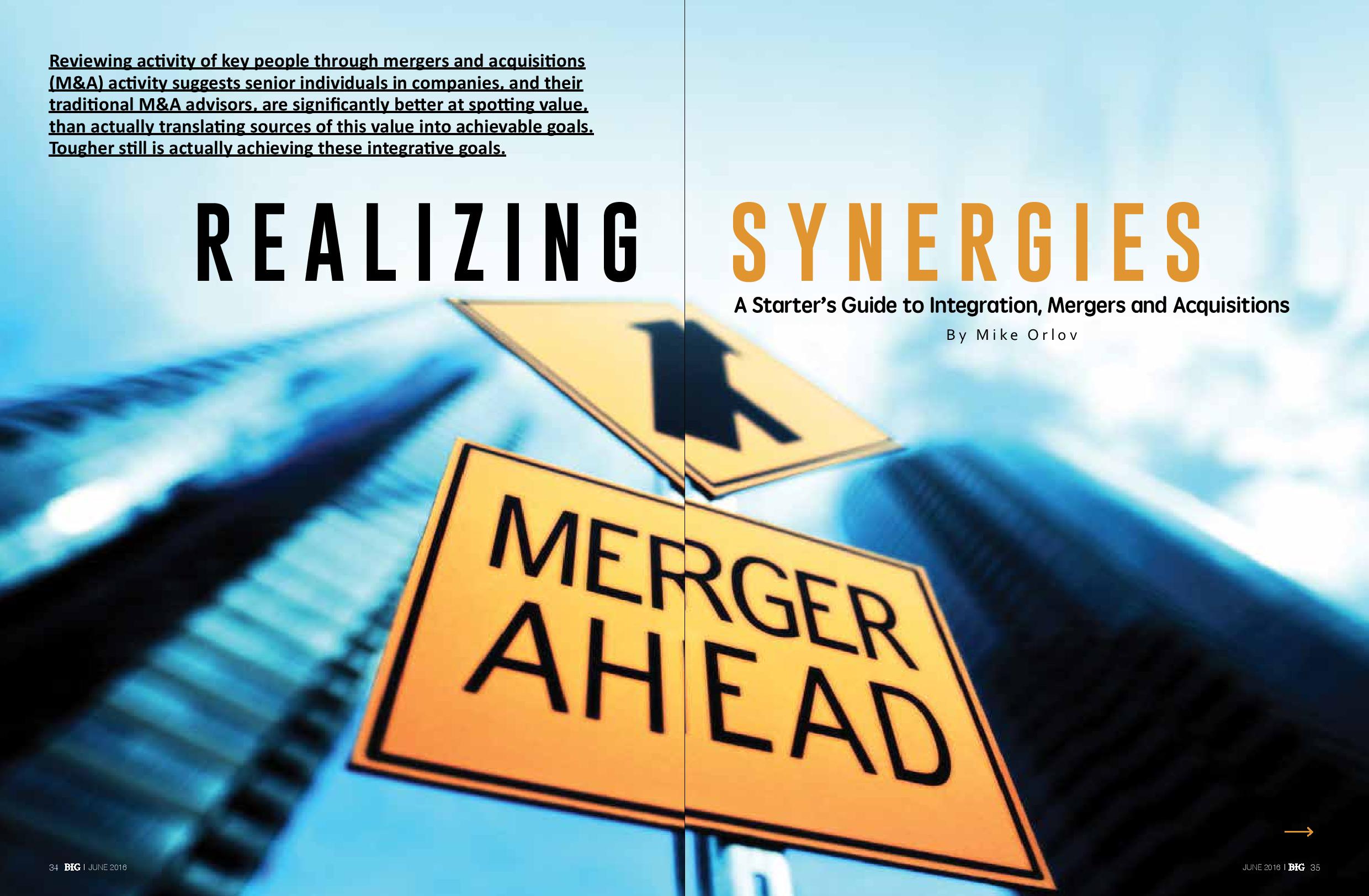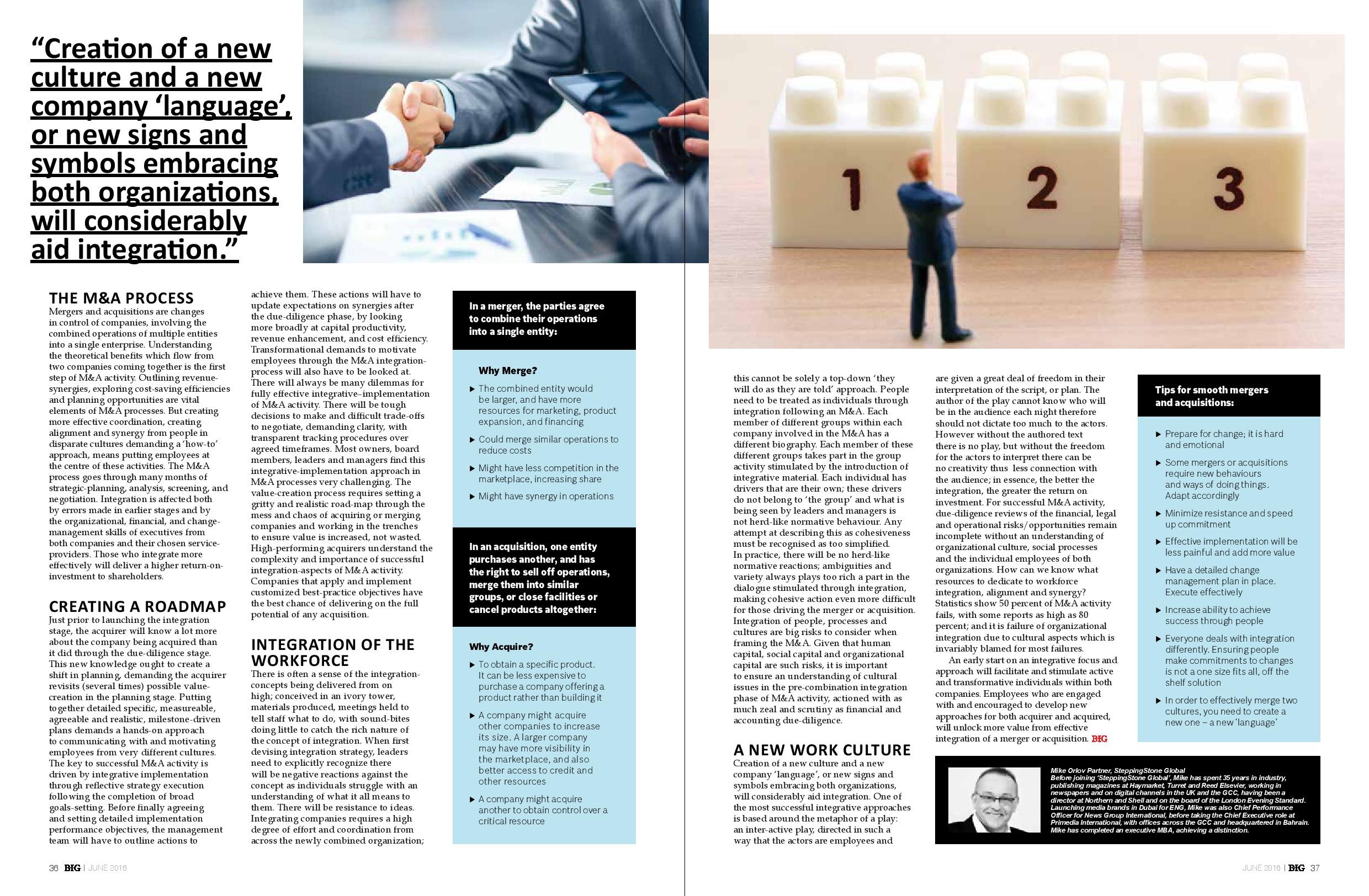
Reviewing activity of key people through mergers and acquisitions (M&A) activity suggests senior individuals in companies, and their traditional M&A advisors, are significantly better at spotting value, than actually translating sources of this value into achievable goals. Tougher still is actually achieving these integrative goals.
Understanding the theoretical benefits which flow from two companies coming together is only the first step of M&A activity. Of course, outlining revenue-synergies, exploring cost-saving efficiencies and planning opportunities are vital elements of M&A processes. But creating more effective coordination, creating alignment and synergy from people in disparate cultures demanding a ‘how-to’ approach, means putting employees at the center of these activities.
The M&A process goes through many months of strategic-planning, analysis, screening, and negotiation; integration is affected both by errors made in earlier stages and by the organizational, operational, financial, cultural-alignment, and change-management skills of executives from both companies and their chosen service-providers. Those who integrate more effectively will deliver a higher return-on-investment to shareholders
Just prior to launching the integration stage, the acquirer will know a lot more about the company being acquired than it did through the due-diligence stage. This new knowledge ought to create a shift in planning, demanding the acquirer revisits (several times) possible value-creation in the planning stage. Setting targets, putting together detailed specific, measureable, agreeable and realistic, milestone-driven plans demands a hands-on approach to communicating with and motivating employees from very different cultures.
Be it an acquisition driven by a more stable, better-funded competitor, or a perceived merger of equals (if such a thing ever happens), the key to successful M&A activity is driven by integrative-implementation through reflective strategy-execution following the completion of broad-goals setting.
There will always be many dilemmas for fully effective integrative–implementation of M&A activity. There will be tough decisions to make and difficult trade-offs to negotiate, demanding clarity, with transparent tracking procedures over agreed timeframes. Most owners, board members, C-Suite, leaders and managers find this integrative-implementation approach in M&A processes very challenging.
The value-creation process requires setting a gritty and realistic road-map through the mess and chaos of acquiring or merging companies and working in the trenches to ensure value is increased, not wasted.
High-performing acquirers understand the complexity and importance of successful integration-aspects of M&A activity. Companies that apply and implement customized best-practice objectives have the best chance of delivering on the full potential of any acquisition.
Before finally agreeing and setting detailed implementation performance objectives, the management team will have to outline actions to achieve them. These actions will have to update expectations on synergies after the due-diligence phase, by looking more broadly at capital productivity, revenue enhancement, and cost efficiency, as well as transformational demands to motivate employees through the M&A integration-process.
There is often a sense of the integration-concepts being delivered from on high; conceived in an ivory tower, materials produced, meetings held to tell staff what to do, with sound-bites doing little to catch the rich nature of the concept of integration. When first devising integration strategy, leaders need to explicitly recognize there will be negative reactions against the concept as individuals struggle with an understanding of what it all means to them.
There will be resistance to ideas. Integrating companies requires a high-degree of effort and coordination from across the newly combined organization; this cannot be solely a top-down ‘they will do as they are told’ approach. People need to be treated as individuals through integration following an M&A
Each member of different groups within each company involved in the M&A has a different biography. Each member of these different groups takes part in the group-activity stimulated by the introduction of integrative material. Each individual has drivers that are their own; these drivers do not belong to ‘the group’ and what is being seen by leaders and managers is not herd-like normative behaviour.
Any attempt at describing this as cohesiveness must be recognised as too simplified. In practice, there will be no herd-like normative reactions; ambiguities and variety always plays too rich a part in the dialogue stimulated through integration, making cohesive action even more difficult for those driving the merger or acquisition.
Integration of people, processes and cultures are big risks to consider when framing the M&A. Given human capital, social capital and organizational capital are such risks, ensure there is understanding of cultural issues in the pre-combination integration phase of M&A activity, actioned with as much zeal and scrutiny as financial and accounting due-diligence.
Creation of a new culture and a new company ‘language’, or new signs and symbols embracing both organizations, will also considerably aid integration. One of the most successful integrative approaches is based around the metaphor of a play: an inter-active play, directed in such a way that the actors are employees and are given a great deal of freedom in their interpretation of the script, or plan. The author of the play cannot know who will be in the audience each night therefore should not dictate too much to the actors. However without the authored text there is no play, but without the freedom for the actors to interpret there can be no creativity thus less connection with the audience; in essence, the better the integration, the greater the return on investment.
For successful M&A activity, due-diligence reviews of the financial, legal and operational risks/opportunities remain incomplete without an understanding of organizational culture, social processes and the individual employees of both organizations. How can we know what resources to dedicate to workforce integration, alignment and synergy? Statistics show 50 percent of M&A activity fails, with some reports as high as 80 percent; and it is failure of organizational integration due to cultural aspects which is invariably blamed for most failures.
An early start on an integrative focus and approach will facilitate and stimulate active and transformative individuals within both companies. Employees who are engaged with and encouraged to form, re-form and then re-form meanings again from new approaches for both acquirer and acquired, will unlock more value from effective integration of a merger or acquisition.
Mergers and acquisitions are changes in control of companies, involving the combination of the operations of multiple entities into a single enterprise
In a merger, the parties agree to combine their operations into a single entity
In an acquisition, one entity purchases another, and has the right to sell off operations, merge them into similar groups, or close facilities or cancel products altogether
Why Merge?
The Combined Entity:
- Would be larger, and have corresponding more resources for marketing, product expansion, and obtaining financing
- Could merge similar operations to reduce costs
- Might have less competition in the marketplace, increasing share
- Might have synergy in operations
Why Acquire?
- Obtain a specific product. It can be less expensive to purchase a company offering a product rather than building it
- A company might acquire other companies to increase its size. A larger company may have more visibility in the marketplace, and also better access to credit and other resources
- A company might acquire another to obtain control over a critical resource
Factors to increase smooth mergers and acquisitions:
- Prepare for change; it is hard and emotional
- Mergers or acquisitions require new behaviors and ways of doing things
- Minimize resistance and speed-up commitment
- Organizational change is inevitable
- Effective implementation will be less painful and add more value
- Have a detailed change management plan in place. Execute effectively
- Increase ability to achieve success through people
- Everyone deals with integration differently. Some people avoid it. Some confront it. Some dive in head first and change everything. People internalize change in different ways. Ensuring people make commitments to changes is not a one size fits all off the shelf solution
- The merging of two cultures, creating a new culture – a new ‘language’
- Culture
Culture is the way work gets done around here; no two cultures are the same. When two ways of doing things are merged, there will be bottlenecks, lack of understanding, bumps in the road as well as roadblocks. Bringing two cultures together is a journey. Organizational culture is not just the result of one swift decision, but an ongoing process and way-of-being. Mourn the past and begin to build a new future together
- Communication is king
Two organizations trying to (or perhaps not trying to) communicate as one. Failing to communicate creates assumptions, declining engagement and productivity collapses; service suffers. Timely communication is vital, explaining the process and impacts, how it affects people, customers, suppliers and other stakeholders, and providing what everyone needs to do to succeed; keeping open reflective and generative dialogues
- Activities and Processes
Conduct a detailed process inventory and impact analysis. Explore overlaps and redundancies. Look at which work well, which need improvement, and which can be integrated. Assess all processes and impacts that might hinder performance and strategic execution. Making organization more flexible and agile while merging the 6 Ms of resources and creating new capabilities
- Train
During a merger or acquisition people often fear their own perceived possible incompetence. They are afraid their job may become obsolete or they may not have the skills to perform successfully in the new environment. People need training on the new processes and technology. Key employees should be a part of developing new processes, and helping to refine and streamline them

